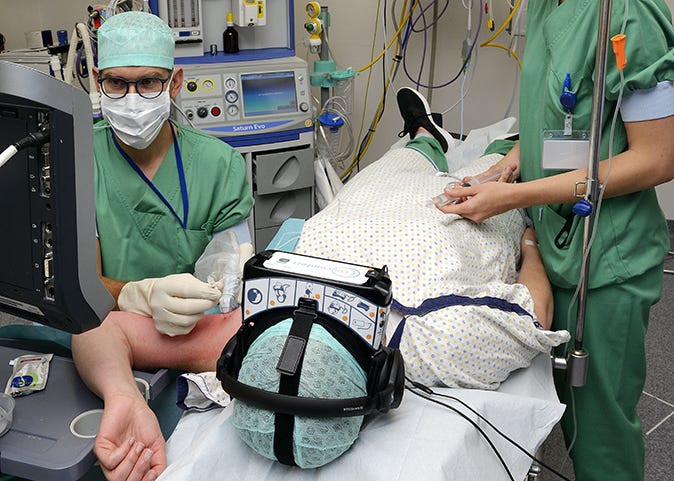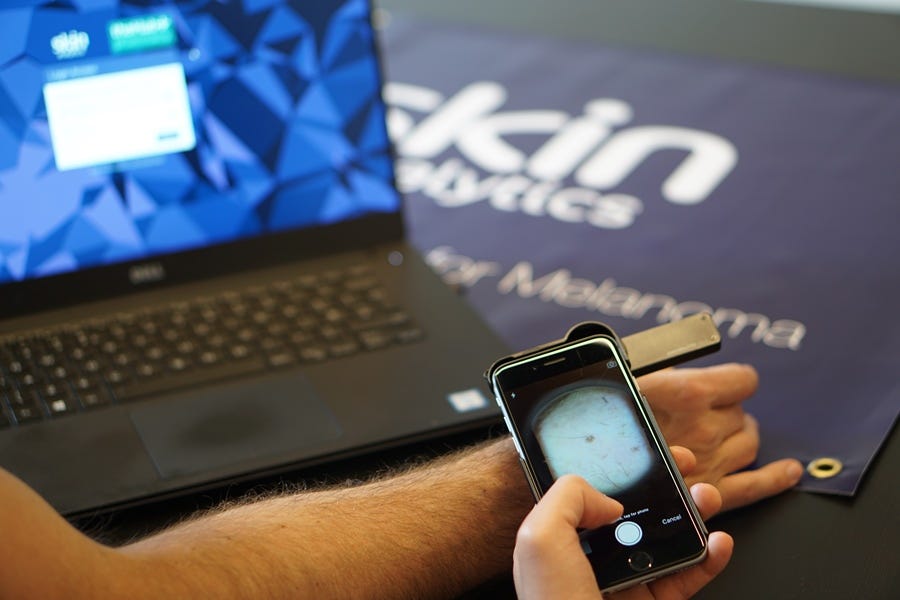Scandinavian legend describes The Kraken as a giant squid like monster that dwells in the sea off the Nordic coasts. It typically terrorizes ships and their sailors as they try to reach safety. This week we will look at a Canadian company that is bringing The Kraken to robotic life. Hopefully the robot will behave better than the legend of old. We also discover a few new AI and VR driven medical applications. We look at Digital Sedation via Virtual Reality and two AI programs. One that detects skin cancer and the other that detects Alzheimer's. Finally we showcase yet another battery. Battery technology is developing at a cracking pace and will be the key to the future electrification of everything. Given the focus on this area we will continue to see a lot more development in the near future.
Kraken Robotics
We are not talking about the legendary cephalopod sea monster from Scandinavian folklore but a new underwater robot being developed at St John’s University in Newfoundland in Canada. The robot being developed by Kraken Robotics will be autonomous and will be capable of staying underwater for a year whilst making decisions on its own.

The robot is designed to be a seabed resident rather than being sent out on a mission and then recovered. The robot is called “Thunderfish XL” and will be able to reach depths of 6 kilometers in the zone of the ocean where light is unable to penetrate. It will live in a docking station between expeditions.
The Thunderfish will be able to make decisions on what it needs to do as it proceeds. If it detects an anomaly in a pipeline or cable that it is inspecting it can autonomously decide if it needs to stop or return to a particular spot. It will use cameras and laser scanners to give high resolution images of what it has found.
The robot will be about 4.5 meters long, 1.5 meters wide and will weigh about 2 tons (depending upon payload). It is designed to unplug from the docking station to work and then to reconnect to recharge whilst it is sending data. Each mission will last from 24 to 36 hours. Initially there will be no intervention capability however that is planned for the future.
Digital Sedation
Belgian company, Oncomfort has developed a range of digital sedation tools to help manage patient’s pain and anxiety, during, before and after medical procedures, without medication.
The three pillars of Digital Sedation are:
Clinical hypnotherapy to bring the patient into a state of dissociation. This technique has been clinically validated and the Oncomfort solution makes hypnotherapy available without training in clinical hypnotherapy.
Integrative therapeutic techniques as reinforcing tools. A wide range of evidence based approaches are integrated into the solution to reinforce the effect of the Digital Sedation.
Virtual Reality (VR) as an accessible and powerful enabler. As an immersive medium, VR combines therapeutic techniques into a unique patient experience. Suitable for both Adults and Children, VR enhances patients state of absorption through immersive auditory and visual experiences while shielding them from environmental stimuli.

The system can be used in Interventional cardiology, radiology, Obstetrics, Oncology pain management, Pediatrics, Surgery, Dental emergencies, Geriatrics, Urology and burns management. The ability to reduce or eliminate chemical sedation improves recovery. The company claims that only 10% of patients under Digital Sedation during regional anesthesia require additional sedation.
Skin Analytics
Skin Analytics is a UK company that has developed an AI to help find skin cancers earlier. Early detection is key to survival. The machine learning algorithm called Deep Ensemble for the Recognition of Malignancy (DERM), recognises the most common malignant, pre-malignant, and benign skin lesions. This includes melanoma, the most dangerous of the common skin cancers.
Most existing solutions for AI detection of skin cancer uses a pre-trained neural network to detect skin cancers. For example, Google trains their ‘Inception Network’ to recognize a dog by showing it thousands of photos of dogs. This same approach is used to train many cancer detecting AI’s.
Skin Analytics uses Deep Learning to train their algorithms. Deep learning allows features which describe the data to be learned directly from the data. Traditional methods required the programmer to directly program ‘feature descriptors’ thus limiting the software to the perception and understanding of the programmer. Deep learning does not rely on the programmers coding of specific features. This allows algorithms to be trained on data in an end-to-end manner, and on highly complex features beyond the understanding of individual programmers. This process has been applied in ‘computer vision’ applications.

The tools are designed for GP’s and other healthcare professionals to better identify skin cancers that need onward referral to specialists. The increased accuracy of identification reduces the need for specialist appointments and unnecessary biopsies. It allows earlier detection and thus a reduction in overall treatment costs and an increase in survival rates.
Alzheimer’s Detection
Researchers at the New Jersey Stevens Institute of Technology have developed an early detection tool for Alzheimer’s by using language. The tool accurately diagnoses people with Alzheimer's with 95% accuracy without the need for scans.
Alzheimer's can alter the way that a suffer uses language and words. For example, patients typically switch nouns with pronouns, or they change the way that they express themselves. Instead of saying “I’m hungry”, they say “my stomach feels bad because I haven’t eaten”. Language deficits occur in 8 to 10% of individuals in the early stages of Alzheimer's and become more severe and numerous during its’ later stages.

The researchers trained the AI using healthy volunteers and Alzheimer's patients by asking the subjects to describe a picture that depicted a child stealing cookies from a jar. The team then converted each of the sentences into a unique numerical sequence by using a tool developed by Google. The system then learned to notice similarities and differences in the sentences spoken by healthy individuals and Alzheimer's patients. Future work will include training the algorithms to understand languages other than English and to learn how this tool could be used to detect other neurological diseases.
Yet more Batteries
I wasn’t going to talk about batteries this week however there are just so many developments at the moment. Also, next week (22 September 2020) Tesla makes their announcements on battery improvements. Rumors are that they will increase the range and decrease the cost for Tesla batteries.
We have mentioned Ultracapacitors (sometimes called Supercapacitors) previously. Estonian company, Skeleton has developed a range of Ultracapacitors for use in Automotive, Grid management, Industrial and Transportation settings.
Ultracapacitors offer high power density, almost instant charging and discharging, high reliability and long lifetimes. They have been in development for a few decades however much of the progress has been made over the past few years. This has been driven by the development of nano materials. Ultracapacitors store electricity in an electric field rather than in a chemical reaction (as most batteries do). This is the main reason that Ultracapacitors work for 15+ years without maintenance.
The ideal applications for ultracapacitors are ones that require high power and constant recycling. Examples are KERS (Kinetic Energy Recovery Systems which were first developed for Formula 1 race cars) where braking energy is stored and reused for acceleration or lighting and grid power quality where tiny disturbances can lead to equipment damage. Applications also include Uninterrupted Power Sources (UPS), starter motors for diesel engines (particularly very large engines like trains and large marine vessels) and certainty of power for medical applications (MRI’s and CT scans).

At the heart of the Skeleton ultracapacitor is a patented Curved Graphene. This nano material allows for up to 4 times the power density compared to competitive products. Continued battery technology development is one of the keys to the electrification of everything that we will see happen over the coming decade.
Paying it Forward
If you have a start-up or know of a start-up that has a product ready for market please let me know. I would be happy to have a look and feature the startup in this newsletter. Also if any startups need introductions please get in touch and I will help where I can.
If you have any questions or comments please email me via my website craigcarlyon.com or comment below.
I would also appreciate it if you could forward this newsletter to anyone that you think might be interested.
Till next week.


